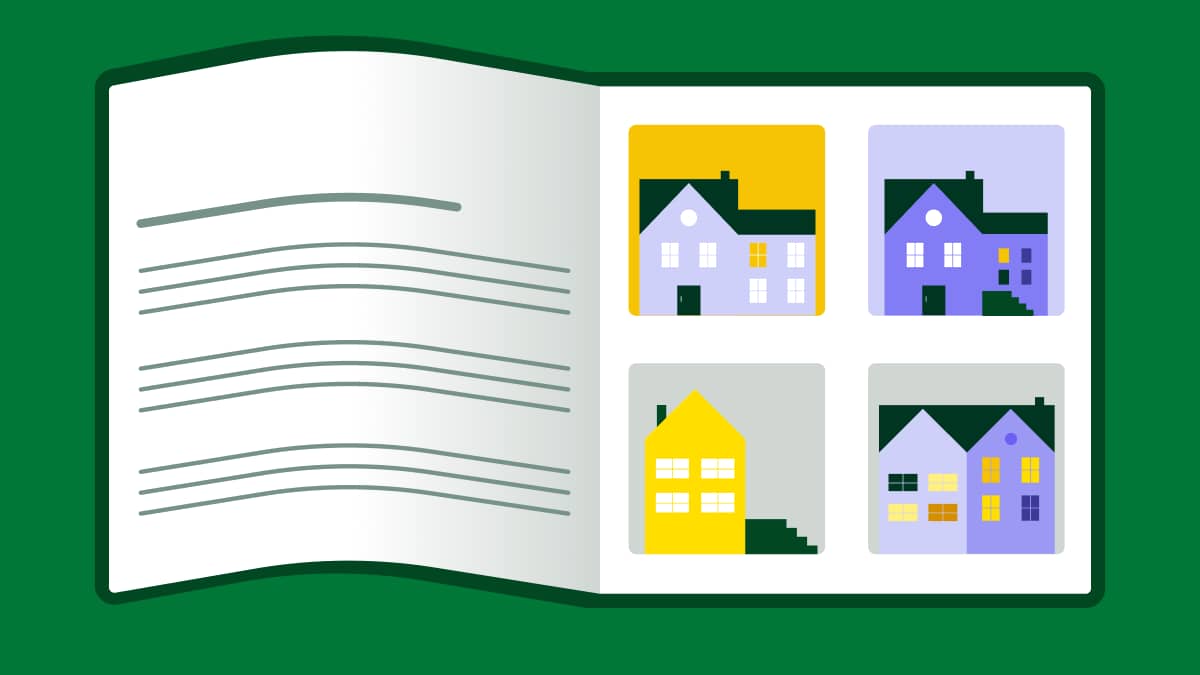Real estate guides attract high-intent prospects and establish your expertise in the local market.
When done well, they capture leads researching their next move and position you as the trusted advisor they’ll call when ready to buy or sell.
In this article, you’ll discover how to create real estate guides that convert browsers into clients. You’ll also get step-by-step advice on promoting your guides and nurturing leads to closed deals.
Key insights from real estate guides
Real estate guides help you attract serious prospects who are actively researching buying or selling decisions by offering valuable local market insights they can’t find anywhere else.
The best guides mix general real estate advice with specific local knowledge, such as neighborhood price trends, seasonal timing tips and trusted local service providers.
Creating successful guides means building a complete system, from researching what prospects want to promote across multiple channels to tracking which sources bring the best leads.
Turn guide downloads into paying clients with automated follow-ups, lead scoring and targeted email campaigns that keep you top-of-mind during long decision cycles. Start your 14-day free trial with Pipedrive to build a system that converts prospects into closed deals.
What are real estate guides?
Real estate guides are lead magnets that offer valuable data in exchange for customer information. They’re typically short documents that explore specific topics that interest real estate prospects.
For instance, a home buyer’s guide for New York might include a checklist for a successful home inspection and an overview of the appraisal process.
A busy professional researching their first home-buying experience would gladly share their email address for this insider knowledge.
Sharing guides helps real estate professionals:
Capture qualified leads. Serious home sellers and potential buyers will sign up for property advice from a realtor, meaning higher conversion rates than general web traffic.
Build trust and authority. Helpful content positions you as the local expert. People will see you as someone who will help them find their dream home and achieve homeownership.
Stay top-of-mind. Prospects will reference your guide throughout the buying or selling journey, and your name will be visible as they make decisions.
Generate referrals. If prospects are satisfied with your guide, they’ll share it with others and recommend you to family and friends.
The key is creating a free guide that solves your target audience’s challenges. Different prospects need different information, which is why successful real estate brokers create multiple guides.
6 types of high-converting real estate guides
Real estate agents focus on six main types of guides to engage customers. Each one solves a specific problem that faces key real estate customer segments:
Real estate guide type | What it covers |
1. First-time real estate buyers’ guides | A cComplete walkthrough of the home-buying process, including local lenders, neighborhood price ranges, inspection checklists and hidden costs to budget for. |
2. Seller preparation guides | Room-by-room preparation checklists, staging strategies that increase sale prices, repair priorities and realistic timeline expectations. |
3. Local market guides | Neighborhood deep-dives with recent prices, school districts, walkability scores, planned developments, statistics and buyer demographics. |
4. Investment property guides | Cash flow calculators, rental yield analysis, tax deduction strategies, property management companies and market opportunity assessments for specific areas. |
5. Downsizing guides | Practical advice for empty nesters, including home valuation strategies, right-sizing tips, moving logistics and finding communities that match their new lifestyle. |
6. Relocation guides | Complete city guide covering utility setup, school enrollment processes, healthcare providers, local services and cultural insights. |
When choosing what to create, consider your customer’s needs. For example, first-time buyers want simple explanations, while sellers need action steps. Similarly, investors look for numbers and data, while people moving to your area need practical local information.
Understanding these motivations helps you create content that drives consultations.
The complete guide to real estate sales
How to create a real estate guide that generates leads
To create a guide that people want to download, research your audience and create strategic content. Follow these four steps to build a high-converting real estate guide.
1. Research your audience’s problems
Research lets you base your guide on what prospects ask about. When you understand their real problems, more people download your guide and contact you.
Start your research by downloading the real estate guides from agents in your area. Read each one and create a spreadsheet for columns about topics, quality and what’s missing.
Here’s an example analysis of three fictional guides and what they’re missing:
Real estate guide and what it’s missing | Your opportunity to stand out |
First-time buyer guide: Missing local lender recommendations. | Include specific banks and credit unions in your area, with interest rates and which lenders work best for different situations. |
Seller’s guide: No mention of virtual tours or digital marketing. | Explain how to create virtual tours and optimize listings using tools like multiple listing services (MLS). |
Real estate investing guide: Only contains general numbers with no local data. | Provide neighborhood-specific rental rates, property taxes and future affordability. Show which areas have stronger demand and why. |
Look for outdated information and generic advice that could apply anywhere. These are good opportunities to create a more up-to-date and helpful guide for local prospects.
Also, pay attention to their lead capture process. How many form fields do they use? How quickly do they follow up? These details help you create a smoother experience.
Next, send a brief survey to your past clients. Ask about the buying or sales process, what information they wish they had earlier and what resources helped them most.
You could also join local Facebook groups for real estate in your area. Look for posts where people ask questions or mention what frustrated them. If multiple people have the same problems, it’s likely a good topic for a real estate guide.
Another solid resource is Reddit, particularly the r/RealEstate and r/FirstTimeHomeBuyer subreddits. Search for posts mentioning your city, and look for universal concerns you can address with local examples.
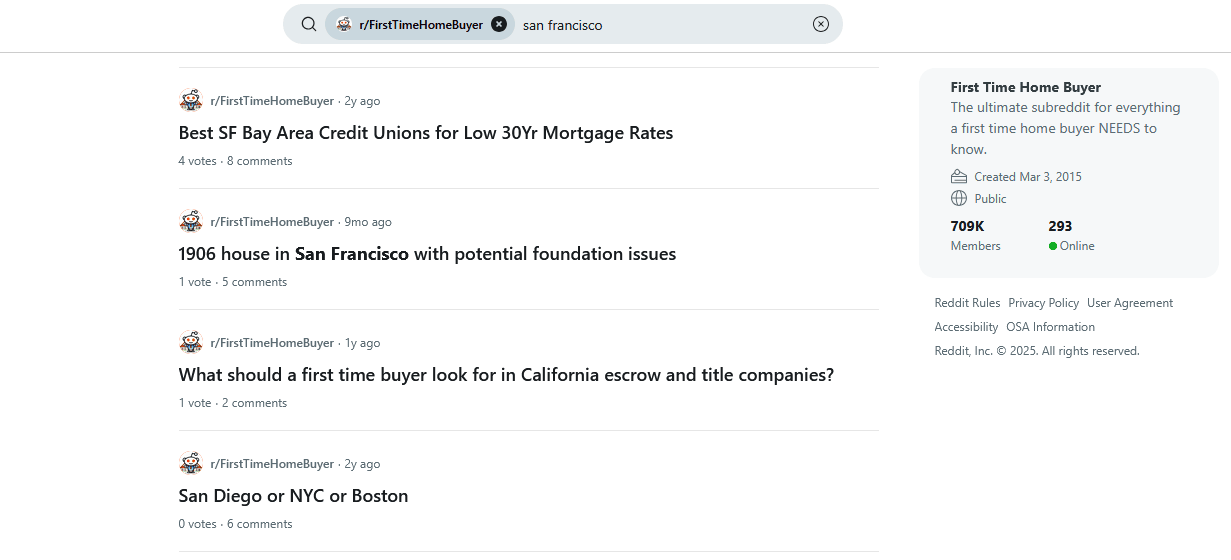
Research takes time, but it separates your guide from prospects who ignore it. You’re building a foundation based on real questions from real people.
2. Structure your guide for maximum engagement
Most people scan content for specific information, rather than reading from start to finish. If you structure your real estate guide for easy reading, you’ll help them find what they want.
Begin each section with a problem. Explain the solution with specific details, then give an actionable next step.
For example, you could open by stating that most first-time buyers underestimate closing costs. Then, explain what closing costs include and provide an easy way for readers to calculate theirs.
It’s also crucial to break your content into bite-sized pieces that busy people can scan. Here’s an example layout from Studio MJA:
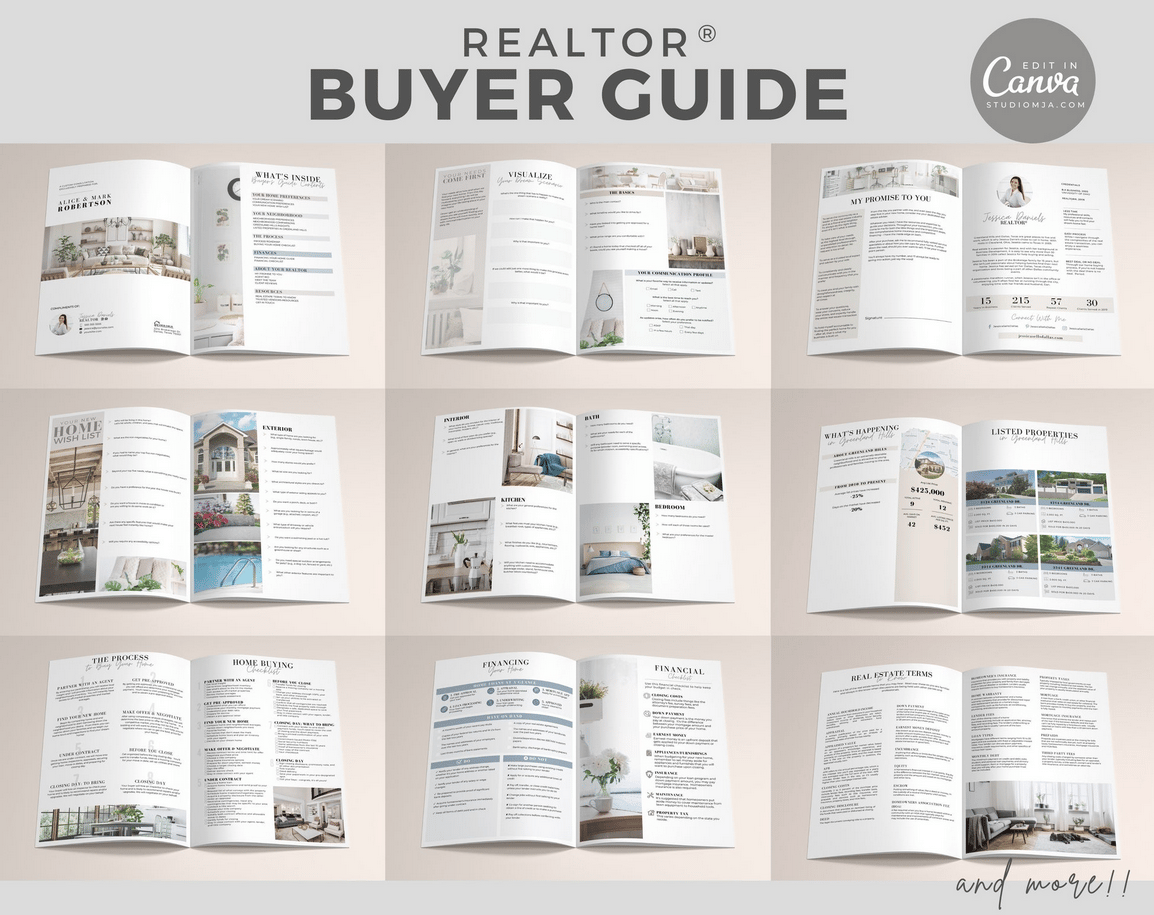
Each section should solve one problem rather than trying to cover everything at once.
To keep readers engaged:
Keep paragraphs to three sentences since readers skip longer blocks of text
Use bullet points for lists of items, steps or tips
Include a table of contents so readers can jump to relevant sections
Add fill-in worksheets, comparison charts and printable checklists
Use charts or graphs to show local data, like market trends and home prices
Break up text with visual elements every 200–300 words to maintain interest
Make your guide as interactive as possible. Include practice calculations and checklists (for online guides) that readers can use during their search.
These tools make your guide more valuable and give prospects a reason to keep it nearby.
3. Add content that builds authority
Local knowledge proves you’re the expert in your area, setting you apart from agents who provide generic advice.
You must prove your know-how to convert leads into clients and help them make informed decisions. Encourage them to do their due diligence and offer to assist with the process.
One of the best ways to show your expertise is by sharing real stories from recent deals. Without using client names, tell readers what you did as the buyer’s agent and how it turned out.
Check out this example from Tamara Williams & Company, showcasing sales metrics for family homes in Bozeman:
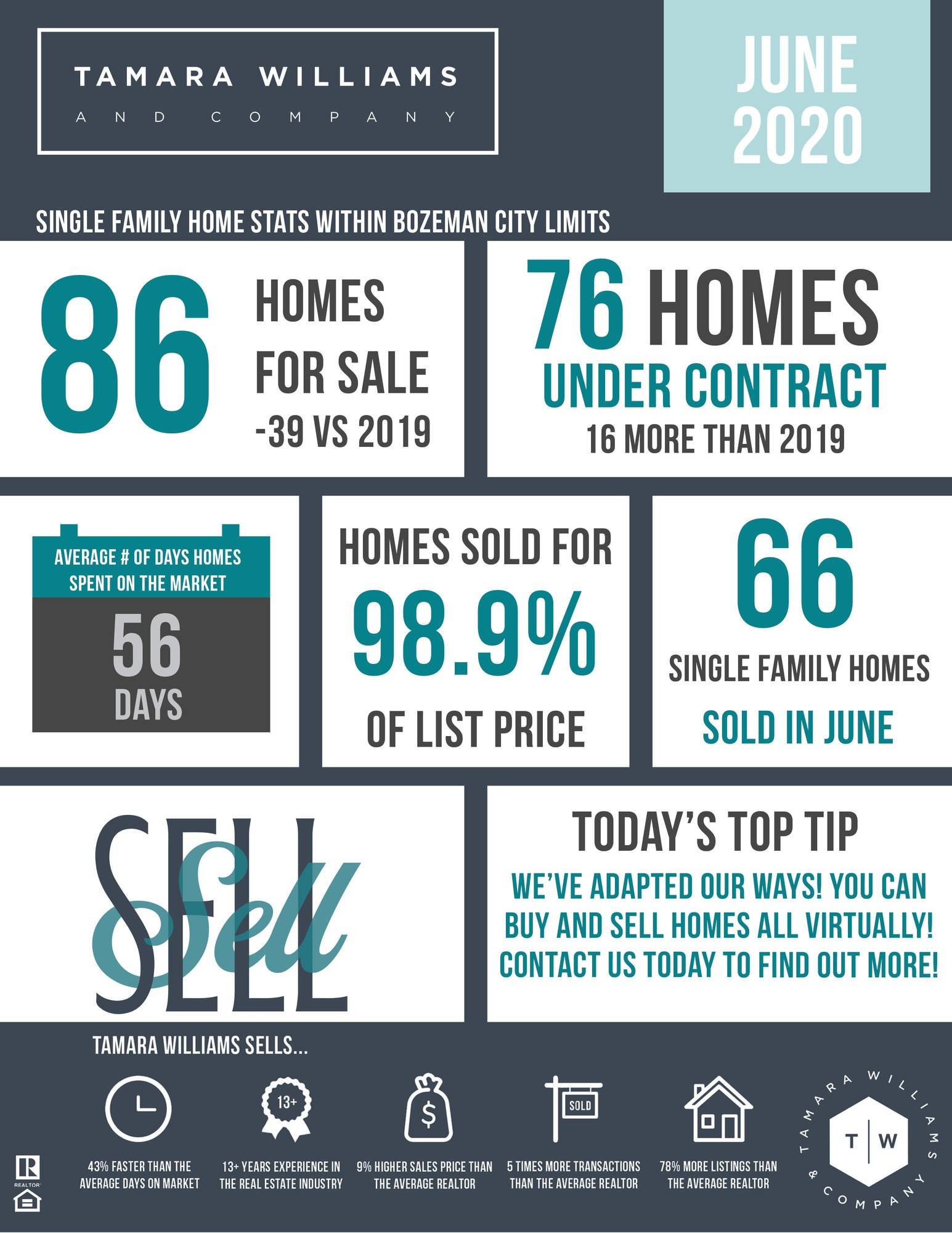
It sets expectations for sellers (like how long their home will be on the market) and shows why this company is worth trusting (they sell houses quicker, more often and for higher prices).
You should also tackle the big worries that keep prospects up at night.
Create sections that address fears like “What if the real estate market is too hot to enter?” or “What if the housing market crashes next year?”. Readers trust you when you calm these fears with actionable data and examples from your deals.
Beyond stories and objection handling, your guide needs content only a local expert could provide. Here’s what works best:
Content type and why it matters | What to include |
Neighborhood price analysis: Shows that you know local values | Include average price per square foot and recent sales KPIs. Example: “Riverside district averages $425/sq ft because of the school rating and new facilities.”. |
Seasonal market timing: Proves that you track patterns that other agents miss | Show data on the best months to buy or sell, average time on market and price differences. Example: “March listings seek 23% faster than December and here’s why”. |
Local inspection issues: Demonstrates your experience with area-specific problems | List common issues like neighborhood age and negotiation strategies. Example: “75% of pre-1985 homes here need electrical updates. Here’s how to handle it”. |
Lender and service provider reviews: Shows you have insider connections | Compare local banks, credit unions and mortgage brokerages. Provide rates for contractors and inspectors you recommend. Example: “For inspections, I recommend Johnson & Associates. They’re thorough and provide same-day reports”. |
Closing cost breakdowns: Proves that you know the real numbers | List every fee buyers pay in your area (including down payments and the average mortgage payment). Example: “In our country, transfer tax is $1,200, title insurance is $650 and attorney invoices are between $800 and $1,000.” |
Bidding strategy examples: Highlights how you win deals in competitive markets | Share recent examples of successful offers and what made them work. Example: “My client won by offering the asking price with a flexible closing date that worked for the seller. Sometimes, timing matters more than money.”. |
Market prediction and trends: Establishes you as a local market expert | Analyze recent data, new project reports, zoning changes and economic factors affecting your area. Example: “The new train station opening will likely increase property values by 15–20% within half a mile, based on similar projects in neighboring areas.”. |
To stand out, make every piece of advice as specific as possible. Instead of saying “get pre-approved”, explain which three local lenders offer the best rates and how to get pre-approval from them.
The more detailed and local your advice, the more valuable readers find your guide.
Note: If you’re in the US, as a National Association of Realtors (NAR) member, you’re bound by a strict code of ethics. Providing accurate, transparent information demonstrates your commitment to these professional standards.
4. Set up lead capture systems
The whole point of creating guides is to generate leads for your real estate business. When someone downloads your guide, they’re genuinely interested. Getting their contact details means you can follow up and turn them into paying clients.
You’ll need a simple landing page for each guide with a clear URL that’s easy to share. It should focus on getting people to download your guide, like this example from Yaletown Realty:
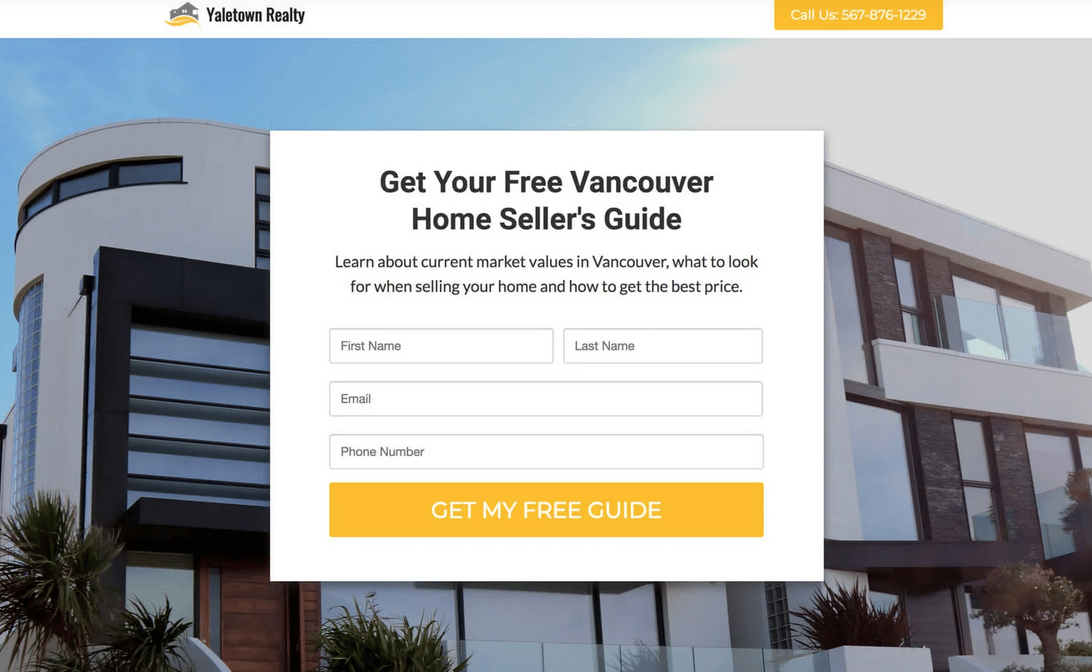
Your headline makes the most significant difference to how many people download your guide. Focus on the specific benefit they’ll get, rather than describing what’s inside.
For instance, “How to Sell Your House Fast in New York” promises a clear outcome, while “Seller’s Guide” doesn’t tell them what they’ll gain from reading it.
Keep your lead form as simple as possible. Once people trust you enough to download your guide, they’ll happily share more details when you follow up.
Pipedrive’s customer relationship management (CRM) system can help you capture leads. You can build sign-up pages using the Web Forms feature.
In Pipedrive, go to the Web Forms section and create a new form with the fields you want to collect.
You’ll get an embed code to paste into your landing page or use the direct link to send people to a form. Anyone who fills it out automatically becomes a new lead in your sales pipeline.
Note: Most people will find your guides through social media, so test your landing pages on mobile devices before you launch them. If your page doesn’t work correctly, you’ll lose potential leads to competitors with better mobile experiences.
How to promote your real estate guides
You need to promote your guide to get downloads and generate leads. The best promotion strategy combines multiple channels to reach prospects wherever they spend time online.
Here’s where to focus your real estate marketing efforts:
Promotional channel | What it works best for |
Email to past clients | All guide types: Past clients already trust you and might refer friends and family. |
First-time buyer and local market guides: People ask questions and seek advice in these communities. | |
LinkedIn posts | Investment property guides: Professionals and homeowners often seek investment advice on LinkedIn. |
Google and Facebook ads | All guide types: Targets people actively searching for real estate help on these platforms. |
Open house flyers | First-time buyer and local market guides: Open house attendees want to buy local property. |
Local newspaper ads | All guide types: Older demographics read local papers to find housing information. |
Radio sponsorship | Local market guides: Commuters hear about your neighborhood expertise while driving through the area. |
Here’s where many real estate professionals hit a roadblock. You’ve promoted your guide across multiple channels, and people download it.
Without a system to follow up with these new leads, you’re missing out on potential clients who showed interest. Targeted email follow-ups are essential.
Pipedrive’s Campaigns feature lets you send these email follow-ups. You can segment your audience based on which guide they download and send relevant content that matches their interests and stage in the buying process.
If someone downloads your investment guide, enroll them in a drip marketing campaign that shares sales successes and market research.
If they’re a first-time buyer, send them an email series with tips on getting pre-approved, what to look for during a home tour and testimonials from other first-time buyers.
How to convert downloads into clients with Pipedrive
Getting downloads is a great start, but your follow-up process turns initial interest into signed agreements. You must build a relationship, demonstrate your value and guide the prospect toward a consultation.
A CRM system is the engine for this process, helping you optimize every interaction. Here’s how to build a system to convert downloads into clients.
1. Create an instant follow-up strategy
When someone downloads your guide, they’re at their most interested. A fast response within the first hour helps you make a strong impression before they lose motivation.
Instead of manually tracking every download, use your CRM’s sales automation tools to engage every lead.
With Pipedrive, you can set up workflow automation to run a welcome email series as soon as someone submits your guide’s Web Form.
Go to “Tools & Apps” > “Automations” and click “+ Automation” to create a new workflow.
Set your trigger to “Web Form is submitted”. Whenever someone fills out your guide forms, it’ll activate the automation.
Next, add an email action to deliver the guide immediately. Click “+ Add action” and select “Send email”. Write a template message that includes the guide attachment and your contact information.
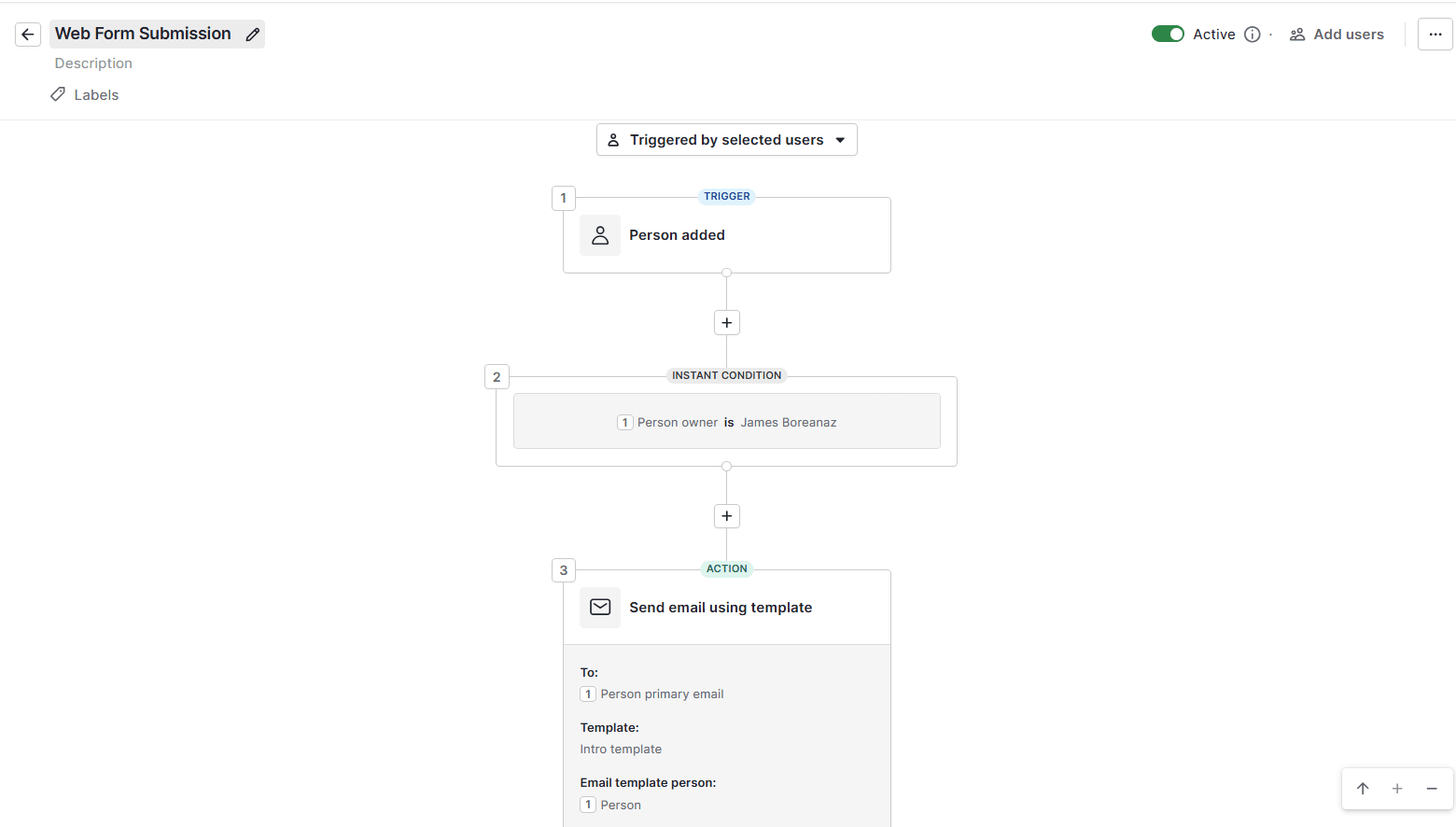
Add another action to create a deal in your real estate pipeline. Set it to route new leads to your first pipeline stage so that every guide download is trackable in your CRM, rather than just sitting in your leads inbox.
You can also schedule an activity like calling real estate leads with the “Create activity” action. Set this for the next day with a clear description like “Follow up on guide download” so you can contact the lead.
2. Use long-term nurturing
Most people take months before they’re ready to buy or sell. Your job is to stay relevant throughout their entire customer journey.
To do this, you must create targeted lifecycle campaigns that provide ongoing value without being pushy.
A CRM with email marketing tools lets you set up different nurturing sequences. For example, with Pipedrive’s Campaigns feature, go to “Marketing” > “Campaigns” and create sequences based on which guide someone downloaded.
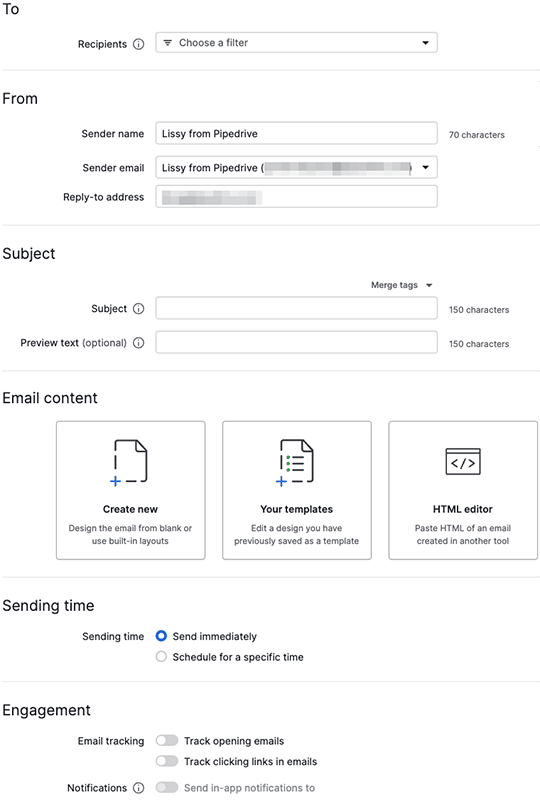
Build a seller sequence that includes things like:
Monthly neighborhood market reports showing recent homes for sale and price trends
Seasonal home selling and improvement tips that increase property value
Recent sales in their area showing how the listing agent secured a great deal for new home sellers
For first-time buyers, create content around:
New listing alerts in their budget and preferred neighborhoods
Mortgage rate updates and changes to lending requirements
Local market timing advice about when to start looking seriously
Schedule these emails to send every 2–3 weeks. Include your contact information and make it easy for people to reply when they’re ready to take the next step.
Pipedrive in action: This approach is exactly how PropriLib uses Pipedrive. Since it handles sellers and buyers, it needed a system to hold both sales cycles.
With Pipedrive’s deal management features and a powerful integration with Slack, PropriLib quickly automated its email sequences, shortened sales cycles and boosted sales.
3. Qualify and score your leads
As you generate leads, you need a way to separate serious prospects from casual browsers. Build a system to determine who needs immediate attention and who is okay with automated nurturing.
Create a simple lead scoring system in your CRM using custom fields. In Pipedrive, go to “Settings” > “Data fields” and add a field called “Lead score” with options for hot, warm and cold.
The real power comes when you connect lead scores to pipeline stages. You can use workflow automation to update scores based on meaningful actions and see their stage.
For instance, you could set up an automation that marks a lead as “hot” when they book a meeting and move to your pipeline’s “Consultation” stage. They’ve taken a concrete step that shows interest, and now you can easily see that at a glance.
In contrast, deals that sit stagnant need a different treatment. Create an automation that changes prospects to “cold” if they haven’t moved through your pipeline in 30 days.
Your routine becomes much more efficient when you can always see your hottest prospects. Filter your contact list so hot leads appear first and spend your most productive hours on the sales conversations most likely to close.
4. Measure success and optimize performance
Track what works to improve your results. Knowing which guide generates the most valuable clients allows you to make more innovative marketing strategies.
Are your investment guides generating higher-value clients than your seller guides? Is Facebook giving you a better return than your local newspaper ads?
Pipedrive tracks where your leads come from when they fill out your online forms. You can see this data in any deal’s detail view under the source information sidebar.
Build custom reports to track your lead-to-client journey using Pipedrive’s Insights feature. Go to “Insights” and click “+ Create” > “Report” to build reports.
With these reports, you can:
Track deals by source using a “Deal Performance” report. Filter by “Status = Won” and group by source origin to see which web forms generate the most closed deals.
Analyze conversion rates by comparing total leads to won deals for each source. See what percentage of downloads from each guide turn into clients. You should adjust your follow-up strategy if the rate is low.
Measure sales velocity using a “Deal Duration” report to determine how long leads from different guides take to move through your entire sales process. Spot which guide types convert faster, and set realistic expectations for future lead generation efforts.
Monitoring these metrics allows you to make data-driven decisions that grow your real estate business faster.
Final thoughts
Real estate guides work when you solve problems for prospects in your local market. Create content only a local expert could provide, then build systems that automatically follow up and track results.
Successful agents treat guides as long-term lead generation assets. They create helpful content and focus their marketing budget on what results in real estate transactions.
Start a 14-day free trial with Pipedrive and see how much easier it is to capture real estate leads and turn them into paying clients.
